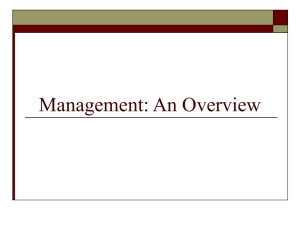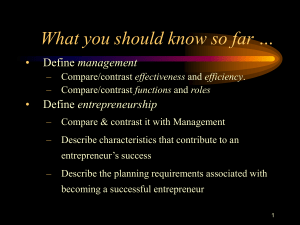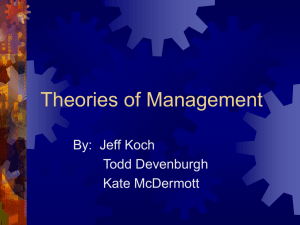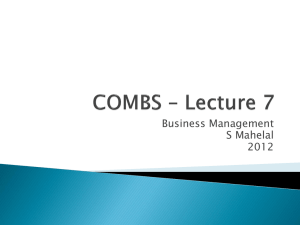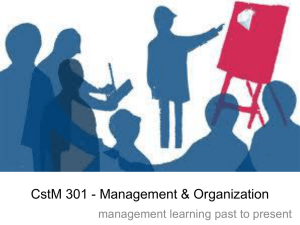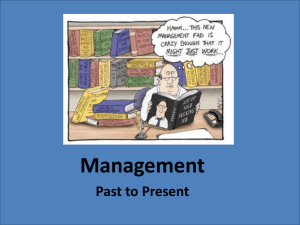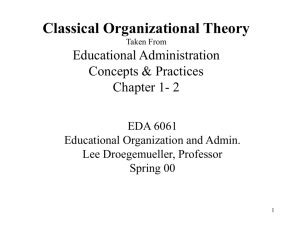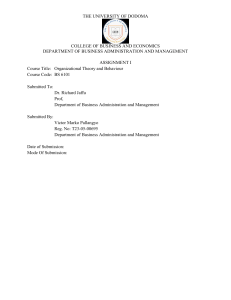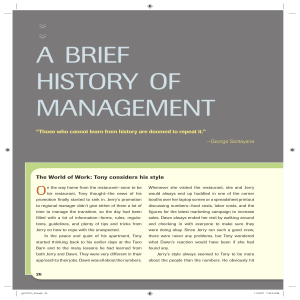History of Management
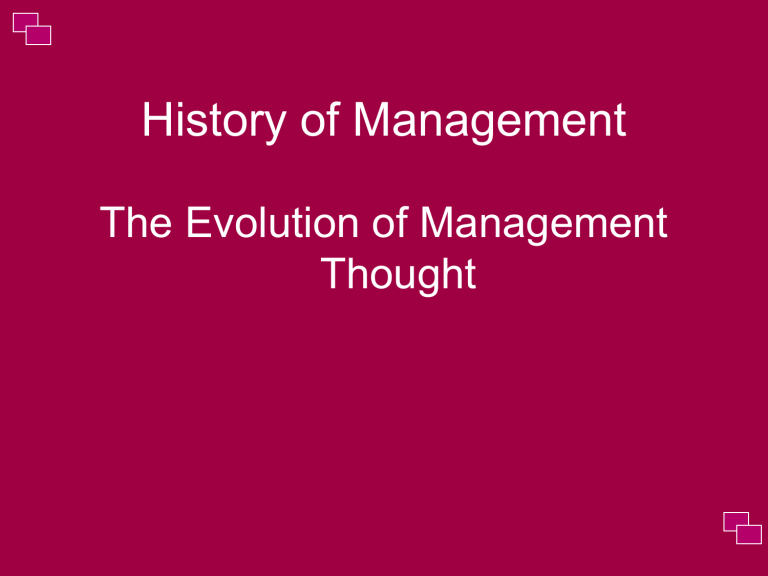
History of Management
The Evolution of Management
Thought
History of Management
Ancient examples of good management
Medieval Example of assembly line
Industrial Revolution prompts study of Management and writings concerning how to manage effectively and efficiently
(Trans. 6)
The Practice of Management has gone on through history but formal study and writing has mainly taken place in the last 100 years.
Information overload is where we’re at now
Interdisciplinary
No universally accepted approach
An early approach to Management is the
The Universal Process Approach or
Administrative Management
Approach
Henri Fayol’s Universal Management Process
Development of principles of Management
Lessons from the Universal Process
Approach
THE UNIVERSAL PROCESS
APPROACH – Administrative
Management Approach
Universal process approach: The administration of all organizations, public or private or large or small, requires the same rational process.
Universal Functions
Henri Fayol’s Five Universal Functions
(also called processes ) of
Management--POC 3
Planning
Organizing
Command
Coordination
Control
Administrative Approach
Henri Fayol’s Five Universal
Functions of Management--
POC
3
Look at book’s functions of management - they are similar to the universal functions of Fayol’s
Functions can be used by all managers non-profit, government, profit making
Fayol summarized Principles of Management in 1916.
Can you come up with them on your own?
How many individuals should directly manage one worker?
How much authority should you give individuals relative to their responsibility?
Should lower level workers directly interact with individuals in different functional areas?
II. Scientific Approach
Started in late 1800’s and early 1900’s.
Frederic Taylor and scientific management
Early followers of Taylor
Later followers are from Quality movement
FREDERICK W. TAYLOR’S
SCIENTIFIC MANAGEMENT
(An Operational Approach)
Scientific management: “that kind of management which conducts a business or affairs by standards established by facts or truths gained through systematic observation, experiment, or reasoning.”
FREDERICK W. TAYLOR’S
SCIENTIFIC MANAGEMENT
(continued)
Taylor’s Scientific Management
Contributions
Standardization (work methods, machine settings
Time and task study (Science of Shoveling)
Systematic selection and training (pretty rudimentary but somewhat unusual at time)
Pay incentives (piece rate)
Early followers of Fred Taylor
Frank and Lillian Gilbreth (12 children) came up with time and motion studies
(therbligs).
Henry Gantt (Gantt chart and work scheduling) also supported a minimum wage with bonuses.
Scientific approach followed
LATER by QUALITY ADVOCATES
W. Edwards Deming -American behind
Japan’s quality revolution based on statistical quality control, employee participation, and continuous improvement
Joseph M. Juran -quality improvement through teamwork, partnerships with suppliers, brainstorming, and Pareto analysis
(80/20 principle)
QUALITY ADVOCATES
(continued)
Armand V. Feigenbaum -total quality control; customer determines quality
Philip B. Crosby -zero defects; “do it right the first time”
• Demonstrated how much defects cost.
– Lost customers, wasted materials and labor, greater costs of servicing items produced
III. The Human Resources
Approach
Focuses in on organized activity that is related to how people behave as individuals and work groups. (soc, psch, soc-psy, mgmt)
Human Relations Movement - developed to make working better for workers - less destructive, more motivating, and more satisfying
Justification for Human
Resources’ Movement and
Behavioral Approach
Threats of Unions
Industrial Humanism
• Mary Parker Follett (need to see employees as having emotions, attitudes, beliefs, habits, feelings-- need to motivate workers.
Hawthorne Experiment (1930’s)
• Elton Mayo (1949)
McGREGOR’S THEORY Y
1960 - Human side of enterprise
Behavioral Approach Continued
McGREGOR’S THEORY Y
Some Modern Assumptions about People
1. Work is a natural activity, like play or rest.
2. People are capable of self-direction and self-control if they are committed to objectives.
3. People will become committed to organizational objectives if they are rewarded for doing so.
McGREGOR’S THEORY Y
(continued)
4. The average person can learn to both accept and seek responsibility.
5. Many people in the general population have imagination, ingenuity, and creativity.
IV. THE SYSTEMS APPROACH
System: a collection of parts operating interdependently to achieve a common purpose.
General systems theory: an interdisciplinary area of study based on the assumption that everything is part of a larger, interdependent arrangement.
IV. Systems Approach
Chester I. Barnard’s Early Systems
Perspective (Book Fcts. Of Executive.
General Systems Theory
New Directions: Organizational Learning and
Chaos Theory
Lessons from the Systems Approach use of open versus closed systems, exchange theory
THE SYSTEMS APPROACH
(continued)
“Functions of Executive” --- This 1938 book stated that all organizations are cooperative systems whose elements must have a willingness to serve, have a common purpose, and must communicate to work together
THE SYSTEMS APPROACH
(continued)
Closed system: a self-sufficient entity.
Open system: an entity that depends on the surrounding environment for survival.
Exchange Theory:
THE SYSTEMS APPROACH
(continued)
For Discussion:
1. What role does open-system thinking play in your life?
2. Why should managers view modern organization as open systems?
V. Contingency Approach”
Contingency approach is similar to systems approach except management scholars realized it is impossible to understand everything in system so they propose to just study major contingencies of system.
Trans 9
V. Contingency Approach
Contingency approach is an effort to determine through research which managerial practices and techniques are appropriate in what situation.
Excellence Approach
Attributes of Excellence: A Modern
Unconventional Approach
Eight Attributes of Excellence in large companies studied
A Critical Appraisal of the Excellence
Approach
Lessons from the Excellence Approach
Peters and Waterman is unconventional
Approach
PETERS AND WATERMAN’S EIGHT
ATTRIBUTES OF EXCELLENCE
1.
A bias for action
2.
Close to the customer
3.
Autonomy and entrepreneurship
4.
Productivity through people
PETERS AND WATERMAN’S EIGHT
ATTRIBUTES OF EXCELLENCE
(continued)
5.
Hands-on, value driven
6.
Stick to the knitting
7.
Simple form, lean staff
8.
Simultaneous loose-tight properties
Excellence approachmay be
MBBS
Joke about book “One Minute Manager” asks what do you do the other 59 minutes.
MBBS syndrome - Management By Best
Seller-- Companies using MBBS approach may be unfocused and have:
Weak culture
Insecure incompetent
Strong top down control
Consultants inexperienced
Unwillingness to expend long-term effort
3.
4.
1.
2.
5.
HOW TO AVOID THE QUICK-FIX
MENTALITY IN MANAGEMENT
Remain current.
Look for scientific support.
Experiment with new concepts.
Be skeptical and analyze apparently simple solutions.
Study linkages between current action and future results.
